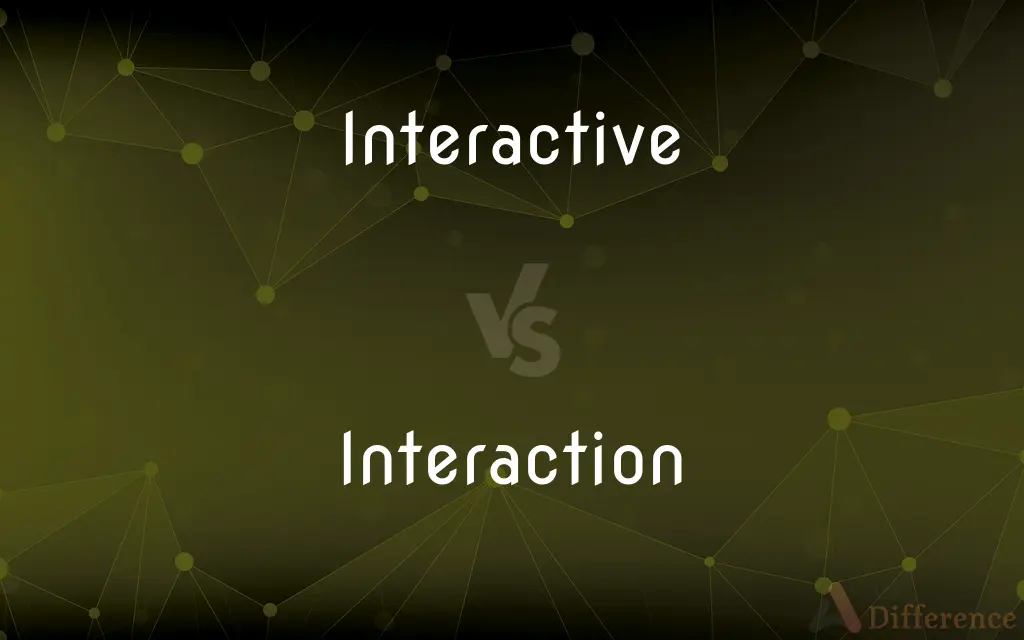Interactive vs. Interaction — What's the Difference?
By Maham Liaqat & Fiza Rafique — Updated on April 27, 2024
"Interactive" describes a medium or environment that allows active participation, usually involving technology, while "interaction" refers to the act or process of two or more entities acting upon each other.

Difference Between Interactive and Interaction
Table of Contents
ADVERTISEMENT
Key Differences
Interactive is used to describe systems, tools, or experiences designed to respond to user inputs or actions, such as interactive software. Whereas, interaction refers to the engagement or communication between people, systems, or organisms.
An interactive feature in digital media typically allows users to manipulate content or navigate through it in real-time. On the other hand, interaction can occur in both digital and non-digital contexts, such as conversations between people or between a user and a computer program.
Interactive learning environments are created to enhance engagement by allowing learners to participate actively in their education process. Whereas, interaction in a learning context might refer to the specific exchanges between students and teachers or among students themselves.
In technology, interactive devices or applications are developed to receive and respond to inputs from users, making them feel a part of the digital experience. On the other hand, interaction within technology can refer to the broader concept of any communicative exchange between hardware and software components, or between technology and users.
In design, interactive elements are those that require user engagement to fully function, such as video games or interactive websites. Whereas, interaction design is a field focused on creating engaging interfaces that facilitate all forms of interactions between users and their devices.
ADVERTISEMENT
Comparison Chart
Definition
Allowing active participation and engagement
The act or process of two or more entities acting upon each other
Context
Often technology-related
Broad, including social, technological, and environmental contexts
Focus in Usage
User engagement and response
Communication and effect between entities
Examples in Digital Media
Interactive tutorials, video games
Online forums, video conferencing
Relationship with Technology
Specifically refers to responsive systems
Broader term encompassing all forms of communicative exchanges
Compare with Definitions
Interactive
Involving communication between people and technology.
Interactive voice response systems guide callers through menu options.
Interaction
A process by which two or more objects or phenomena affect each other.
The interaction between the medication and alcohol can be dangerous.
Interactive
Allowing two-way flow of information between a computer and a user.
His thesis focused on the design of interactive educational tools.
Interaction
In social sciences, a dynamic process involving two or more social entities.
Social media platforms are primarily designed to facilitate interaction among users.
Interactive
Pertaining to software or systems allowing user input.
She developed an interactive map that showed different statistical data based on the user's choice.
Interaction
In physics, the transfer of energy between elementary particles, objects, etc.
Scientists study the interaction of particles within the atom.
Interactive
Designed to respond to the actions of a user.
The museum's interactive exhibit allows visitors to experience historical events through augmented reality.
Interaction
Communication or direct involvement with someone or something.
Her research explores the interaction between teachers and students in virtual classrooms.
Interactive
Requiring active participation or engagement.
The teacher used interactive games to teach mathematics.
Interaction
In chemistry, a mutual or reciprocal action or influence.
He is interested in the interaction of these two chemicals.
Interactive
Acting or capable of acting on each other.
Interaction
Interaction is a kind of action that occurs as two or more objects have an effect upon one another. The idea of a two-way effect is essential in the concept of interaction, as opposed to a one-way causal effect.
Interactive
(Computers) Of or relating to a program that responds to user activity.
Interaction
The act or process of interacting.
Interactive
Of, relating to, or being a form of television entertainment in which the signal activates electronic apparatus in the viewer's home or the viewer uses the apparatus to affect events on the screen, or both.
Interaction
The state of undergoing interaction.
Interactive
Interacting with or communicating with and reacting to each other; influencing or having an effect on each other; acting or capable of acting on each other or with the other.
Interactive teaching methods
Two interactive systems
Interaction
(Physics) See fundamental interaction.
Interactive
(computer science) Responding to the user.
Interactive user interface
Interaction
The situation or occurrence in which two or more objects or events act upon one another to produce a new effect; the effect resulting from such a situation or occurrence.
Be aware of interactions between different medications.
Interactive
A feature (as in a museum) that can be interacted with.
Interaction
A conversation or exchange between people.
I enjoyed the interaction with a bunch of like-minded people.
Interactive
Used especially of drugs or muscles that work together so the total effect is greater than the sum of the two (or more)
Interaction
Intermediate action.
Interactive
Capable of acting on or influencing each other
Interaction
Mutual or reciprocal action or influence; as, the interaction of the heart and lungs on each other.
Interaction
The effect, such as exertion of a force, that one object exerts on another, especially the capture or emission of a particle.
Interaction
Communication between people, or the actions of people that affect others.
Interaction
A mutual or reciprocal action; interacting
Interaction
(physics) the transfer of energy between elementary particles or between an elementary particle and a field or between fields; mediated by gauge bosons
Common Curiosities
Why is interactive design important?
It enhances user experience by making technology more engaging and easier to use.
What is the significance of interaction in ecosystems?
Interactions in ecosystems, such as predator-prey dynamics and symbiosis, are crucial for maintaining ecological balance.
What makes something interactive?
It involves systems or elements that respond to user inputs or engage users in active participation.
What are examples of interactive technology?
Examples include interactive kiosks, smart home devices, and educational software.
How do physicists study particle interactions?
They use particle accelerators and detectors to observe and measure the forces and energies involved.
Can interaction occur without technology?
Yes, interaction can be as simple as a conversation or physical activity between people.
What are the benefits of interactive marketing?
It can lead to higher engagement rates, better customer insights, and more effective communication.
How is interaction different from communication?
Interaction includes all forms of reciprocal influence and exchange, while communication specifically refers to the exchange of information.
How does interactive media affect user behavior?
It can increase engagement, improve learning outcomes, and influence decision-making processes.
What skills are important for designing interactive systems?
Skills in UX/UI design, programming, and an understanding of human behavior are key.
How do interactions shape social relationships?
They determine the nature of relationships, influence social dynamics, and affect personal development.
What role does interaction play in education?
It enhances learning by engaging students directly and fostering a more dynamic educational environment.
Can interaction be negative?
Yes, interactions can be negative if they involve conflict or produce undesirable effects.
Can interactive systems replace traditional learning methods?
While they can enhance traditional methods, they do not necessarily replace them but rather complement them.
What makes an interaction effective in professional settings?
Clarity, mutual respect, and purpose-driven communication are key factors for effective interactions in professional environments.
Share Your Discovery

Previous Comparison
Amphiprotic vs. Polyprotic
Next Comparison
Polymer vs. CopolymerAuthor Spotlight
Written by
Maham LiaqatCo-written by
Fiza RafiqueFiza Rafique is a skilled content writer at AskDifference.com, where she meticulously refines and enhances written pieces. Drawing from her vast editorial expertise, Fiza ensures clarity, accuracy, and precision in every article. Passionate about language, she continually seeks to elevate the quality of content for readers worldwide.
















































